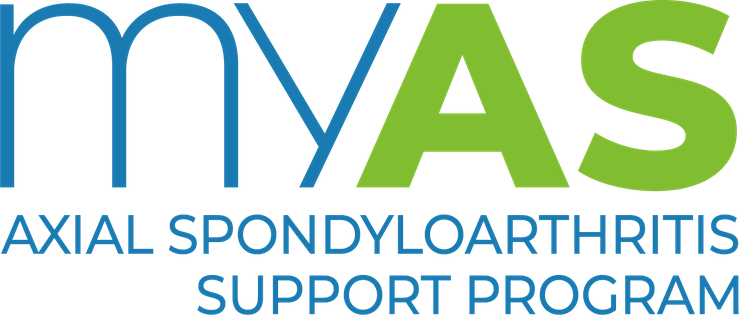
Why axSpA puts you at greater risk for heart disease.
Axial spondyloarthritis (axSpA) can be a lot to manage. Not only are you likely to be dealing with the daily symptoms like joint pain and stiffness, it’s also important to keep in mind that axSpA can impact other systems of your body as well, like your heart. People with axSpA have an increased risk of developing heart disease compared the general population.
While heart disease is a serious health condition, just because you have axSpA doesn’t mean that you are guaranteed to develop it. With the right screening and preventive health measures you can reduce your risk and keep your heart and blood vessels healthy. Keep reading for steps you can take to protect yourself against heart disease. Remember, this article should not replace expert medical advice and is recommended you talk to your doctor if you are concerned about heart disease.
What is heart disease?
Heart disease is a term that is used to describe a range of different conditions including:
- Atherosclerosis is where substances, such as cholesterols, build up on artery walls. Eventually, these substances can form something called ‘plaques’. These plaques make the blood vessels narrower, causing the heart to have to pump harder. The plaques can also rupture, causing a blood clot. Atherosclerosis is what causes most heart attacks and strokes.
- Ischemic heart disease is when there is not enough blood flow to the heart and can bring symptoms such as chest pressure, angina and a low tolerance for activity.
- Coronary heart disease is a narrowing of the blood vessels that carry blood and other nutrients to the heart muscle. This condition is sometimes also known as ‘coronary artery disease’ and is caused by atherosclerosis.
- Angina is a feeling of pain or discomfort in the chest, usually during some form of activity, like walking, or when feeling strong emotions. Angina may be caused by a lack of blood or oxygen to the heart.
- Aortitis is inflammation of the aorta, the large artery that takes blood from the heart and distributes to the rest of the body.
- Cardiomyopathy is the enlargement and weakening of the heart
- Heart attack occurs when one of the blood vessels supplying the heart with oxygen becomes completely blocked. This causes the muscle of the heart beyond the blockage to become starved of oxygen.
- Heart failure occurs when the heart can’t pump enough blood around the body. There are a number of different things that may cause heart failure, but the most common causes are heart attack or high blood pressure.
- Stroke occurs when something happens that stops oxygen and nutrients getting to the brain. Strokes are categorised as either ‘ischaemic’ or ‘haemorrhagic’.
- Ischaemic strokes occur when there is a blockage of blood to the brain. There are a number of different things that can cause these blockages, including plaques forming in the blood vessels of the brain (atherosclerosis) or when a blood clot travels to the brain, usually from the heart, and gets stuck and blocks the vessel.
- Haemorrhagic strokes occur when the wall of a blood vessel in the brain breaks and blood leaks into the brain, stopping the oxygen and nutrients being delivered.
Why does axSpA increase the risk of heart disease and what can you do to protect yourself?
There are two main reasons why people with axSpA have an increased risk of heart disease: chronic inflammation and shared risk factors.
Substances called ‘cytokines’, that are involved in the inflammation that damages the joints in axSpA, can also damage blood vessels, increasing the risk of heart disease. Inflammation causes plaque build-up in the arteries, resulting in atherosclerosis and increasing the risk of having a heart attack or strokes.
The other reason people with axSpA are more likely to develop heart disease is shared risk factors. These shared risk factors include:
High blood pressure
A number of factors can increase blood pressure in people with axSpA, including lower levels of exercise due to sore joints. Some of the medications that are often prescribed to people with axSpA, such as non-steroidal anti-inflammatory drugs (NSAIDs) or corticosteroids, can also increase blood pressure. If left untreated, over time high blood pressure can damage the blood vessels and the muscle of the heart, contributing to the risk of heart attack or heart failure.
Obesity
Obesity is linked to the risk of heart disease itself as well as to other risk factors such as high blood pressure and high blood sugar. Fat cells also release inflammatory substances that can increase body-wide inflammation and heart disease risk. People with axSpA may be at risk of obesity due to sore joints making it difficult to exercise. This lack of physical activity can make it hard to maintain a healthy weight. Corticosteroid use has also been linked to weight gain and obesity, making it more difficult for people with axSpA who use corticosteroids to maintain a healthy weight.
Smoking
Not only is smoking linked to more severe joint destruction, but smoking also accelerates blood vessel damage and contributes to artery narrowing. Because of this, smokers have a higher risk for cardiovascular events than non-smokers, potentially compounding the heart disease risk for people with axSpA.
You can reduce your risks
While all of this information may be a bit overwhelming, there are a number of things you can do to protect your heart and reduce the risk of heart disease.
One of the best ways to protect your heart is by taking the disease-modifying antirheumatic drug (DMARD) your rheumatologist prescribes, whether that’s methotrexate, a biologic DMARD or another medication. There’s evidence that controlling axSpA inflammation also reduces the risks of heart attack, stroke and other cardiovascular events. When it comes to lifestyle interventions, the same advice applies whether you have axSpA or not.
Stay active - Doing aerobics and strengthening exercises on most days of the week can protect your blood vessels, help you lose weight and reduce the risk of heart disease. There’s also evidence that exercise can fight inflammation. Refer to Exercise and psoriatic arthritis for more information about how to stay active while living with axSpA
Eat well - Add extra fruits and vegetables to your diet. Eat fatty fish like salmon and tuna, which are high in anti-inflammatory omega-3 fatty acids. Avoid highly processed and ‘fast foods’ as these contain high levels of saturated and trans fats, which contribute to weight gain and heart disease.
Control stress - Practise relaxation techniques like deep breathing and meditation and try and live mindfully to control stress and reduce its impacts.
Quit smoking - Quitting smoking can be hard but it’s not impossible. There are a number of methods to help you quit, such as nicotine replacement therapy, medications or counselling. Even if you’ve tried quitting before, keep trying. You may find a method you haven’t tried before or you might find that one that hasn’t worked in the past works now. Speak with you doctor about what methods are available or call the Quitline on 13 78 48 or go online at icanquit.com.au. The Quitline also have Aboriginal and multilingual advisors available.
Watch your numbers - Have your blood sugar, blood pressure and cholesterol levels checked regularly. If they’re high, speak with your doctor. They may recommend that you try to lower them with diet and exercise or may prescribe you medications to help if necessary.
Find alternate pain-relieving methods - Although NSAIDs and corticosteroids are effective at relieving pain and bringing down inflammation, these medicines can also increase your heart risks. Talk to your doctor about other treatment options. Try to use the smallest dose needed to manage your pain for the shortest time possible. Try other pain relief methods as well, such as heat, ice or physical therapy.
Monitor your heart health
When you have axSpA you need to keep an eye on how your heart is going. To do this, there will likely be some screening tests your rheumatologist and GP will recommend such as regular tests of your blood pressure, blood sugar and cholesterol.
The European League Against Rheumatism (EULAR) recommends heart health screening at least once every five years and every time you change your axSpA medication. Your doctor may also want to do a stress test, echocardiogram or electrocardiogram to check your heart health. These are non-invasive tests that check how your heart performs while doing activity or how your heart is pumping.
Be watchful for any symptoms of heart disease, such as shortness of breath, chest pain, or arm pain and report them to your doctor right away.
Although having axSpA increases the risks of heart disease, hopefully following some of the advice contained in this resource can help you to feel back in control.
For more information about how to maintain a healthy heart, visit The Heart Foundation www.heartfoundation.org.au
This resource has been developed based on the best available evidence. A full list of references is available upon request.









